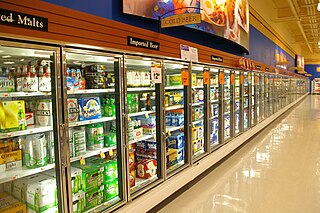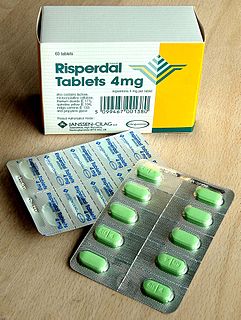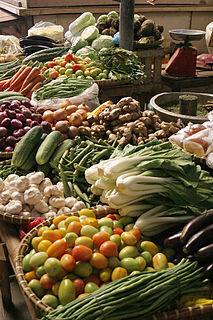
Biotechnology is a broad area of biology, involving the use of living systems and organisms to develop or make products. Depending on the tools and applications, it often overlaps with related scientific fields. In the late 20th and early 21st centuries, biotechnology has expanded to include new and diverse sciences, such as genomics, recombinant gene techniques, applied immunology, and development of pharmaceutical therapies and diagnostic tests. The term biotechnology was first used by Karl Ereky in 1919, meaning the production of products from raw materials with the aid of living organisms.
Food preservation includes food processing practices which prevent the growth of microorganisms, such as yeasts, and slow the oxidation of fats that cause rancidity. Food preservation may also include processes that inhibit visual deterioration, such as the enzymatic browning reaction in apples after they are cut during food preparation. By preserving food, food waste can be reduced, which is an important way to decrease production costs and increase the efficiency of food systems, improve food security and nutrition and contribute towards environmental sustainability. For instance, it can reduce the environmental impact of food production.

Genetic engineering, also called genetic modification or genetic manipulation, is the direct manipulation of an organism's genes using biotechnology. It is a set of technologies used to change the genetic makeup of cells, including the transfer of genes within and across species boundaries to produce improved or novel organisms. New DNA is obtained by either isolating and copying the genetic material of interest using recombinant DNA methods or by artificially synthesising the DNA. A construct is usually created and used to insert this DNA into the host organism. The first recombinant DNA molecule was made by Paul Berg in 1972 by combining DNA from the monkey virus SV40 with the lambda virus. As well as inserting genes, the process can be used to remove, or "knock out", genes. The new DNA can be inserted randomly, or targeted to a specific part of the genome.

The term refrigeration means cooling a space, substance or system to lower and/or maintain its temperature below the ambient one. In other words, refrigeration is artificial (human-made) cooling. Energy in the form of heat is removed from a low-temperature reservoir and transferred to a high-temperature reservoir. The work of energy transfer is traditionally driven by mechanical means, but can also be driven by heat, magnetism, electricity, laser, or other means. Refrigeration has many applications, including household refrigerators, industrial freezers, cryogenics, and air conditioning. Heat pumps may use the heat output of the refrigeration process, and also may be designed to be reversible, but are otherwise similar to air conditioning units.
Flavr Savr, a genetically modified tomato, was the first commercially grown genetically engineered food to be granted a license for human consumption. It was produced by the Californian company Calgene, and submitted to the U.S. Food and Drug Administration (FDA) in 1992. On May 18, 1994, the FDA completed its evaluation of the Flavr Savr tomato and the use of APH(3')II, concluding that the tomato "is as safe as tomatoes bred by conventional means" and "that the use of aminoglycoside 3'-phosphotransferase II is safe for use as a processing aid in the development of new varieties of tomato, rapeseed oil, and cotton intended for food use." It was first sold in 1994, and was only available for a few years before production ceased in 1997. Calgene made history, but mounting costs prevented the company from becoming profitable, and it was eventually acquired by Monsanto Company.

Freezing food preserves it from the time it is prepared to the time it is eaten. Since early times, farmers, fishermen, and trappers have preserved grains and produce in unheated buildings during the winter season. Freezing food slows decomposition by turning residual moisture into ice, inhibiting the growth of most bacterial species. In the food commodity industry, there are two processes: mechanical and cryogenic. The freezing kinetics is important to preserve the food quality and texture. Quicker freezing generates smaller ice crystals and maintains cellular structure. Cryogenic freezing is the quickest freezing technology available due to the ultra low liquid nitrogen temperature −196 °C (−320 °F).

A warehouse is a building for storing goods. Warehouses are used by manufacturers, importers, exporters, wholesalers, transport businesses, customs, etc. They are usually large plain buildings in industrial parks on the outskirts of cities, towns, or villages.

Packaging is the science, art and technology of enclosing or protecting products for distribution, storage, sale, and use. Packaging also refers to the process of designing, evaluating, and producing packages. Packaging can be described as a coordinated system of preparing goods for transport, warehousing, logistics, sale, and end use. Packaging contains, protects, preserves, transports, informs, and sells. In many countries it is fully integrated into government, business, institutional, industrial, and personal use.
Agribusiness refers to the enterprises, the industry, the system, and the field of study of the interrelated and interdependent value chains in agriculture and bio-economy. The primary goal of agribusiness is to maximize profit while sustainably satisfying the needs of consumers for products related to natural resources such as biotechnology, farms, food, forestry, fisheries, fuel, and fiber — usually with the exclusion of non-renewable resources such as mining.

Food engineering is a scientific, academic, and professional field that interprets and applies principles of engineering, science, and mathematics to food manufacturing and operations, including the processing, production, handling, storage, conservation, control, packaging and distribution of food products. Given its reliance on food science and broader engineering disciplines such as electrical, mechanical, civil, chemical, industrial and agricultural engineering, food engineering is considered a multidisciplinary and narrow field. Due to the complex nature of food materials, food engineering also combines the study of more specific chemical and physical concepts such as biochemistry, microbiology, food chemistry, thermodynamics, transport phenomena, rheology, and heat transfer. Food engineers apply this knowledge to the cost-effective design, production, and commercialization of sustainable, safe, nutritious, healthy, appealing, affordable and high-quality ingredients and foods, as well as to the development of food systems, machinery, and instrumentation.

Modified atmosphere is the practice of modifying the composition of the internal atmosphere of a package in order to improve the shelf life. The need for this technology for food arises from the short shelf life of food products such as meat, fish, poultry, and dairy in the presence of oxygen. In food, oxygen is readily available for lipid oxidation reactions. Oxygen also helps maintain high respiration rates of fresh produce, which contribute to shortened shelf life. From a microbiological aspect, oxygen encourages the growth of aerobic spoilage microorganisms. Therefore, the reduction of oxygen and its replacement with other gases can reduce or delay oxidation reactions and microbiological spoilage. Oxygen scavengers may also be used to reduce browning due to lipid oxidation by halting the auto-oxidative chemical process. Besides, MAP changes the gaseous atmosphere by incorporating different compositions of gases.

A cold chain is a temperature-controlled supply chain. An unbroken cold chain is an uninterrupted series of refrigerated production, storage and distribution activities, along with associated equipment and logistics, which maintain quality via a desired low-temperature range. It is used to preserve and to extend and ensure the shelf life of products, such as fresh agricultural produce, seafood, frozen food, photographic film, chemicals, and pharmaceutical products. Such products, during transport and when in transient storage, are sometimes called cool cargo. Unlike other goods or merchandise, cold chain goods are perishable and always en route towards end use or destination, even when held temporarily in cold stores and hence commonly referred to as "cargo" during its entire logistics cycle. Adequate cold storage, in particular, can be crucial to prevent quantitative and qualitative food losses.

Vegetables are parts of plants that are consumed by humans or other animals as food. The original meaning is still commonly used and is applied to plants collectively to refer to all edible plant matter, including the flowers, fruits, stems, leaves, roots, and seeds. An alternate definition of the term is applied somewhat arbitrarily, often by culinary and cultural tradition. It may exclude foods derived from some plants that are fruits, flowers, nuts, and cereal grains, but include savoury fruits such as tomatoes and courgettes, flowers such as broccoli, and seeds such as pulses.

Packaging engineering, also package engineering, packaging technology and packaging science, is a broad topic ranging from design conceptualization to product placement. All steps along the manufacturing process, and more, must be taken into account in the design of the package for any given product. Package engineering is an interdisciplinary field integrating science, engineering, technology and management to protect and identify products for distribution, storage, sale, and use. It encompasses the process of design, evaluation, and production of packages. It is a system integral to the value chain that impacts product quality, user satisfaction, distribution efficiencies, and safety. Package engineering includes industry-specific aspects of industrial engineering, marketing, materials science, industrial design and logistics. Packaging engineers must interact with research and development, manufacturing, marketing, graphic design, regulatory, purchasing, planning and so on. The package must sell and protect the product, while maintaining an efficient, cost-effective process cycle.

Food packaging is packaging for food. A package provides protection, tampering resistance, and special physical, chemical, or biological needs. It may bear a nutrition facts label and other information about food being offered for sale.

The term fish processing refers to the processes associated with fish and fish products between the time fish are caught or harvested, and the time the final product is delivered to the customer. Although the term refers specifically to fish, in practice it is extended to cover any aquatic organisms harvested for commercial purposes, whether caught in wild fisheries or harvested from aquaculture or fish farming.
Order processing is the process or work-flow associated with the picking, packing and delivery of the packed items to a shipping carrier and is a key element of order fulfillment. Order processing operations or facilities are commonly called "distribution centers" or "DC's". There are wide variances in the level of automation associating to the "pick-pack-and-ship" process, ranging from completely manual and paper-driven to highly automated and completely mechanized; computer systems overseeing this process are generally referred to as Warehouse Management Systems or "WMS".
Value-added agriculture refers most generally to manufacturing processes that increase the value of primary agricultural commodities. Value-added agriculture may also refer to increasing the economic value of a commodity through particular production processes, e.g., organic produce, or through regionally branded products that increase consumer appeal and willingness to pay a premium over similar but undifferentiated products. It can also be described as the process that transforms the raw agricultural product into something new through packaging, processing, cooling, drying, extracting, and other processes that change a product from its original raw form. As a result of this transformation, the customer base of a product and revenue sources for the producer are expanded.

A container is any receptacle or enclosure for holding a product used in storage, packaging, and transportation, including shipping. Things kept inside of a container are protected by being inside of its structure. The term is most frequently applied to devices made from materials that are durable and are often partly or completely rigid.
Food and biological process engineering is a discipline concerned with applying principles of engineering to the fields of food production and distribution and biology. It is a broad field, with workers fulfilling a variety of roles ranging from design of food processing equipment to genetic modification of organisms. In some respects it is a combined field, drawing from the disciplines of food science and biological engineering to improve the earth's food supply.












